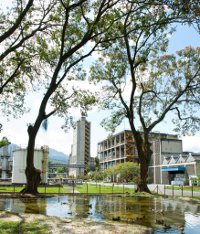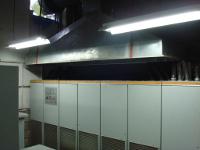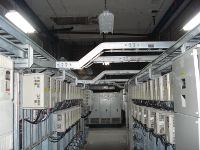Paul Avery, Technical Training Services, Yaskawa America, Inc.
Now more than ever, using the latest technology to save energy, time, and money is very important, as the ENKA de Colombia Co. realized when the time came to update part of their manufacturing process. By combining the ingenuity of ENKA's engineers with high quality products from vendors that they have come to rely on -- including VFDs from Yaskawa -- ENKA improved nearly all aspects of the Nylon and Polyester Spinning Line portion of their manufacturing process.

ENKA de Colombia S.A., in existence in one form or another since 1964, is now the biggest synthetic fibers producer in the Andean Region, NTC-ISO 9001/2000 certified for design, production, commercialization, and service associated with resins, fibers, polyester, and polyamide filament yarns and tire cord fabric. Current product lines include CORLEN® FIBER, CORLEN® and Nylon Filament Yarns, and PET and nylon resins.
Part of ENKA's manufacturing process for filaments involves extruding strands of filament from melted resins. The strands are run over various rollers at varying speeds to stretch, or draw, the strand to the proper size. This spin section is called the Spinning Line.
The Original Installation
The decision to review the Spinning Line process was due not to product quality but to a need to increase manufacturing efficiency. Before the process update, VFD efficiency was anywhere from 20% to 70%. Part of the process was on an Uninterruptible Power System (UPS), due to the critical nature of the line. Necessary as it was, however, the UPS lacked energy efficiency, running at 80% to 93% efficiency.
Many of the Spinning Line's motor drives were dc based; combined motor and drive efficiency hovered around the 50% mark. Based on energy usage alone, the line was in need of an update to the latest technology.
Wasted energy was not the only reason for the update, however. The equipment used on the line prior to the update also produced copious amounts of heat during operation. Elevated temperatures led to increased breakdowns and extended downtime. And when the repair technicians were working on the Spinning Line, they weren't servicing other parts of the plant, which increased downtime for all of ENKA's manufacturing operation.
The Update

Once the decision was made to upgrade the Spinning Line, ENKA decided to use a new design, created by their own engineering group, for the UPS system. When it came to replacing the dc motors and drives, ENKA chose to go the ac route and began specifying products from international companies with longstanding reputations for making highly reliable products. Again, reducing downtime was of the utmost importance to ENKA.
To update the variable speed control used on the spinning line, ENKA went with Yaskawa's F7 and G7 AC VFD sold by the Yaskawa local representative, Variadores S.A. It had nominal 98% efficiency and produced much less heat while operating under load than the older dc and ac drives. The heat was reduced so much that the 9 air conditioning units previously necessary to cool the installation were removed, reducing energy consumption and freeing up precious space near the spinning lines. (Shown left, the old drives; below right, the new drives.)
The dc motors were removed and replaced with energy-efficient ac motors that were also smaller than the original motors. The updated UPS design relied heavily on battery banks and offered near 100% efficiency.
The Results

The results of the update were more than ENKA could have hoped for. In addition to their highly efficent operational capabilities, the Yaskawa VFDs were installed in a common bus manner. This allowed power from one drive that was decelerating its load to provide power to another drive that was accelerating its load. Though not completely balanced, it did allow for the VFD to recover power from load and therefore reduce the power being drawn from the mains.
The energy savings came from three main sources: higher efficiency equipment (VFD, motors, and UPS), removed air conditioning units, and energy reclaimed from the load itself. Using 100% usage, the kWhr havings per year worked out to be $806,131.
The space savings also mattered to ENKA. The original area required for the old spinning line eletrical equipment required 324 m2. After removing the air conditioning units and updating the VFDs, the same electrical installation was only 108 m2, giving a space savings of over 65%. ENKA used the newly freed space to store chips and add a transport station that was closer to production and thus saved time.
Finally, due to the versatility of the new Yaskawa VFDs, certain machines could produce up to 18 different types products at a time with very little modification. This was not an original objective of the update, but was a welcome benefit because it saved time in the production cycle.
Final Numbers
When all of the upgrade was finally done, it was time for ENKA to put some numbers to their project. The total cost of the upgrade came in right on the mark at $678,019, which matched the preliminary budget.
ENKA used 100% usage for determining savings. As stated previously, total savings for all of the lines came in at just $806,131. ENKA felt so strongly about the reliablity of the new equipment that they also calculated the savings based on technician time normally spent keeping the line running before the upgrade vs what was necessary afterward, and added that amount -- $77,077 -- into their payback calculations. The final savings tally was $883,201, which means that the payback timeline came in at under a year.
ENKA set out to use the latest ideas and equipment to help them make world class products while saving time, energy, space, and money. By using their own highly efficient design for a UPS and updating to highly efficient Yaskawa VFDs and energy-efficient motors, they managed to update their manufacturing line to a more efficient, cooler, and highly reliable installation that even, in the end, saved them space -- space that they were able to put to good use to become even more efficient. All with an expected payback of less than a year!





